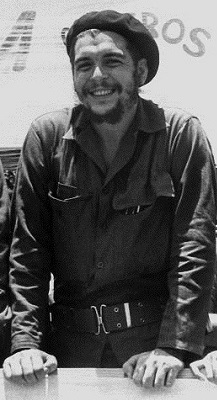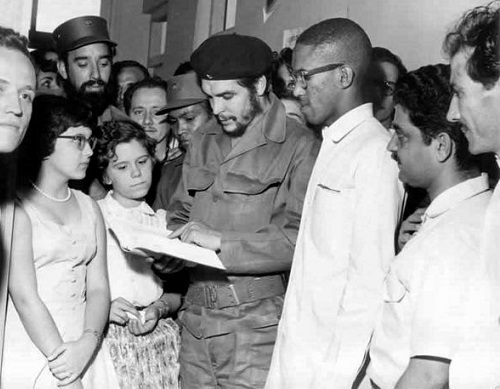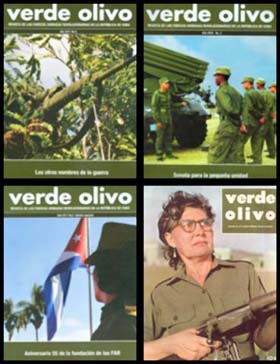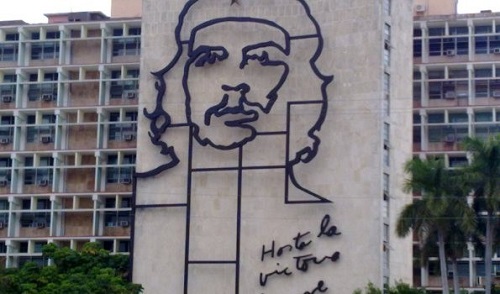|
~ Ernesto Che Guevara
~ Galéria
~ Oldal
~ Bejelentkezés
~ Vissza a Főoldalra
Ernesto Che Guevara, az argentin származású forradalmár, miniszter, gerillavezér és író, Buenos Aires-ben szerzett orvosi diplomát, majd a kubai forradalom során jelentős szerepet játszott a szigetország felszabadításában és újjáépítésében. A kubai gazdaság talpraállításáért dolgozott, küzdött az oktatás és az egészségügy fejlesztéséért, az írástudatlanság és a faji előítéletek felszámolásáért. Saját példájával népszerűsítette az önkéntes munkát. Kongóban és Bolíviában is harcolt - harminckilenc éves volt, amikor az amerikai-bolíviai csapatok csapdába ejtették és kivégezték.
| | |
|

| | |
|
|
|
See Rare Vintage Photos of Cuba Before the Revolution
|
|
|
"See Rare Vintage Photos of Cuba Before the Revolution" - this is how a new book, titled Cuba Now is promoted on the website Parade. It contains amazing photographs about an era, lost in the past, though the one about Che Guevara was taken many years after the Revolution.
Here is the article:
"Cuba in the nineteenth century was defined by its vibrant nightlife, heady music, and a life of dancing, sports, politics, and struggle. The new book Cuba Now (Monacelli Press) showcases the colorful culture of Cuba before Castro with images from one of the largest archive of vintage photographs from the island nation.
From the earliest daguerreotypes to glamorous shots of movie stars, the photos feature a rich spectrum of personalities: race-car driving aristocrats, sultry showgirls, gangsters, everyday folk, and revolutionaries who would soon transform the nation.
Click through to see rare images of Castro as a schoolboy, a bare-chested Che Guevara, Ernest Hemingway on set, and more."
Source
If you want to see all the nine photos, click on the source link above.
If you want to see the half-naked Che Guevara playing chess during a sugar cane harvest in Camagüey, in 1964, then please click here: [Che Guevara photo] Don't forget to click on the photo to be able to see it in a bigger size because it is a HQ one. ;)
|
|
|


| 2014.04.16. 00:00, Aleida |
Ernesto “Che” Guevara enfermero de YPF, en la marina mercante argentina
|
|
|
I have found an interesting article but unfortunately it is in Spanish language, so only those will be able to enjoy it who can speak Spanish well.
It tells about the young Ernesto Guevara: when he worked as a male nurse on an Argentinian commercial ship, Anna G, when he met his first love, Chichina and when he made his famous motorcycle trip with Alberto Granado.
Most of the sources are well-known for hardcore Guevara "fans": Anderson, Castañeda, Taibo II and Che's father.
[Click here to read the whole article in Spanish]
|
|
|
| 2014.04.14. 15:08, Aleida |
Che Guevara and the magazine Verde Olivo
|

|
|
Three months after the victory of the Cuban Revolution, on 10 April 1959 the magazine Verde Olivo (Olive Green, the colour of the uniform of the Rebel Army) was first published - by the initiative and support of the commanders Raúl Castro, Camilo Cienfuegos and Ernesto Che Guevara.
First it had only eight pages, but within a year it was extended into sixteen pages in the form of a weekly magazine, the organ of the Revolutionary Armed Forces.
Che didn't only give his full support to the magazine. He wrote several articles, carefully edited by himself, that were published in Verde Olivo. After he returned home in September 1959, after accomplishing a three-month-long tour of visiting several Asian, African and European countries, he handed in a series of articles about his experiences abroad.
And Che kept on writing articles for the magazine - using the pseudonym El Francotirador (The Sniper) - the same name that he used when writing for the Cuba Libre magazine in the Sierra Maestra.
He wrote about national and international affairs and about the US plans to defeat the Cuba and its revolutionary government - 19 pieces in the section titled Sin Bala (Without a Bullet). In another section called Consejos al Combatiente (Advices for Combatants) between 1961 and 1964 he published several articles about his experiences during the Cuban Revolutionary War - these writings were later grouped into book form with the title Reminiscences of the Cuban Revolutionary War.
On 18 October 1967 Fidel Castro said:
"He wrote with the virtuosity of a classical language. His narration about the [revolutionary] war is unsurpassable. The depth of his thoughts is awesome. He never wrote about anything that he didn't know with extraordinary seriousness, with extraordinary depth, and it is no doubt that some of his writings will be preserved in the future as classic documents of the revolutionary thinking."
[Source]
Some covers of the Verde Olivo

Here is another article, commemorating the 55th birthday of the magazine Verde Olivo - in Spanish - [Cuba Periodistas]
|
|
|


| 2014.04.12. 09:45, Aleida |
Is There A Connection Between Hillary Clinton's 'Shoe-icide' Attacker And Che Guevara?
|
|
|
Is There A Connection Between Hillary Clinton's 'Shoe-icide' Attacker And Che Guevara?
Hillary Clinton faced one of her toughest opponents yet in the early run-up to her purported 2016 presidential run Thursday night when an irate “shoe-icide” attacker hurled a clunky piece of footwear and a copy of a Cold War-era document at the former U.S. Secretary of State.
Just moments after Clinton took the stage for her keynote speech at an Institute of Scrap Recycling Industries convention in Las Vegas Thursday night, a woman walked down the aisle to within six rows of the front of the seating area, threw the items, turned around, put her hands in the air and walked toward the back of the room. Security officers quickly caught up with her.
But while everyone is talking about the shoe, little is talked about what the woman also threw along with it: a copy of a Department of Defense document labeled confidential and dated August 1967; it referred to an operation "Cynthia" in Bolivia. Operation “Cynthia” was a Bolivian army maneuver to capture Argentinean doctor and Cuban revolutionary Ernesto “Che” Guevara.
Guevara was in Bolivia leading a band of guerrilla attempting to overthrow the country’s government in a revolution similar to one he participated in with Fidel Castro in the late 1950s. Bolivian forces eventually wounded and captured Guervara, who was eventually executed on October 9, 1967 on orders from Bolivian President René Barrientos.
Why the woman threw the documents is unclear. She didn’t speak to reporters or explain the action. Brian Spellacy, U.S. Secret Service supervisory special agent in Las Vegas, said the shoe hurler was being questioned and would face criminal charges. Spellacy declined to identify the woman, and he said it wasn't immediately clear what the charges would be.
[Source]
|
|
|


| 2014.04.11. 19:59, Aleida |
Cuba: Castro, Cigars and Cuba Libres
|

|
|
It has never been more pressing to visit the Caribbean island of Cuba. Travellers need to experience the country in its current unique state, before its doors open to capitalism and the bulldozers and coca-cola advertisements.
Stepping into Havana was like stepping back into the 1950s. Cuba’s capital city is suffering, or celebrating, an on-going time warp. The crumbling building facades and uneven road surfaces are just some of the very evident pointers that Cuba is a country falling into an undeniable need of repair.
Yet the city is wonderful. 1950s Cadillacs cruise the roads, acting as taxis for tourists and locals alike. The city is full of life and colour, with every bar playing live Cuban music to the casual drinkers who sit and watch the heat rise from the tarmac. The people are wonderfully laid back and offer you Romeo Y Julieta or Cohiba cigars from one of the local factories. There’s also salsa dancing in the streets and the backstreet bars. I had a lesson when I was there, and I was, quite frankly, appalling.
Aside from the vibrancy of Havana, there is a variety of sights and things to do across Cuba. The country conforms to the necessary checklist for all Caribbean islands; the beaches are perfect. I’m not talking April mornings off the coast of Wales with icy waters and seagulls, I’m talking white sands and shimmering sea that runs into the sky, which stays bright until ruined by glorious sunsets.
Cuba’s variety continues when you look at the country’s history. The island still reveres the revolutionary Che Guevara. His picture is plastered everywhere, shops sell postcards of him and there’s a museum dedicated to his life. The visitor attraction explains how he helped Castro liberate Cuba from Batista’s dictatorial rule; the leader who allowed the Americans to use Cuba as its ‘playground’ back in the 50s. It’s not just Guevara’s face that is drawn all over Havana, the streets are also covered in beautiful street art.
The country’s crumbling nostalgia continues largely due to the ongoing embargo imposed by the USA, whose frosty relationship resulted from the Cold War’s Cuban Missile Crisis of 1962. Raul Castro, Cuba’s leader, has begun to allow change. His country is beginning to allow privatisation and trade, although socialism is still prevalent. The ration cards, for example, ensure all people have basic access to food at reduced prices, a Cuban arrangement that celebrated its fiftieth anniversary last year.
However, the poverty in the country is clear. I can’t help but feel that now is the time to visit, before Cuba becomes westernised any further.
Experience the country in its current unique state, before its doors open to America. The time has never been more pressing to visit.
[Source]
|
|
|


| 2014.04.11. 00:00, Aleida |
| | |
|
|
|
~ Ernesto Che Guevara
~ Gallery
~ Site
~ Log in
~ Back to the Main page
Ernesto Che Guevara, the Argentine-born revolutionary, minister, guerrilla leader and writer, received his medical degree in Buenos Aires, then played an essential part in the Cuban Revolution in liberating and rebuilding the country. He did his best to set up the Cuban economy, fought for the improvement of the education and the health system, the elimination of illiteracy and racial prejudice. He promoted voluntary work by his own example. He fought in the Congo and in Bolivia - he was thirty-nine years old, when he was trapped and executed by the joint American-Bolivian forces.
| | |
|
|

